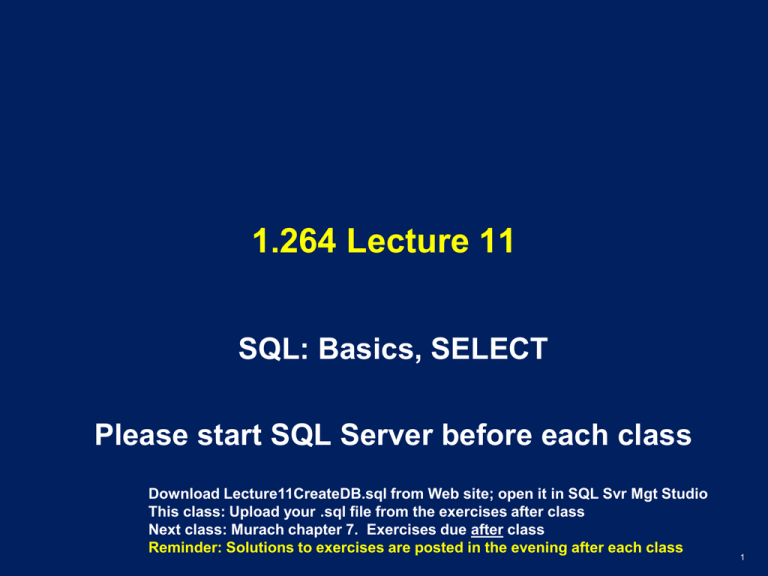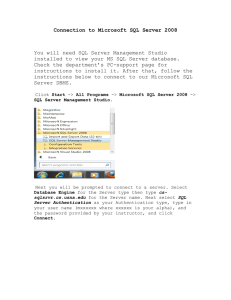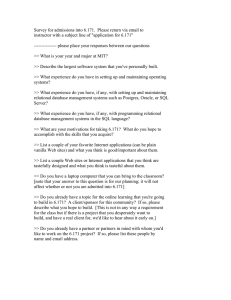1.264 Lecture 11 SQL: Basics, SELECT
advertisement

1.264 Lecture 11 SQL: Basics, SELECT Please start SQL Server before each class Download Lecture11CreateDB.sql from Web site; open it in SQL Svr Mgt Studio This class: Upload your .sql file from the exercises after class Next class: Murach chapter 7. Exercises due after class Reminder: Solutions to exercises are posted in the evening after each class 1 Building a database • When building a database by loading data based on a data model: – It may build well, which usually means you found the real business rules – It may build with some errors, which usually means you have the real business rules but the data is sloppy – It may build with many errors, which usually means that you were told the business rules people wish to have or think they have, not the ones they actually use • It’s often useful to get some sample data and browse it while building the data model 2 SQL • Structured query language (SQL) used for – Data definition (DDL): tables and views (virtual tables). These are the basic operations to convert a data model to a database – Data manipulation (DML): user or program can INSERT, DELETE, UPDATE or retrieve (SELECT) data. – Data integrity: referential integrity and transactions. Enforces keys (primary and foreign) – Access control: security – Data sharing: by concurrent users • Not a complete language like Java, Visual Basic or C++ SQL is sub-language of about 30 statements Embedded in another language or tool for database access SQL has several inconsistencies; NULLs are problematic Portable across operating systems and somewhat among vendors – Declarative language, not procedural – – – – 3 Things that vary among SQL implementations • Error codes • Data types supported (dates/times, currency, string/text variations) • System tables, about the structure of the database itself • Interactive SQL • Programming interface: no vendor follows the standard • Dynamic SQL, used for report writers and query tools • Implementer-defined variations within the standard • Database initialization, opening and connection • Whether case matters (upper, lower case) 4 SQL SELECT • SELECT constructed of clauses to get columns and rows from one or more tables or views. Clauses must be in order: – – – – – – – SELECT columns/attributes INTO new table FROM table or view WHERE specific rows or a join is created GROUP BY grouping conditions (columns) HAVING group-property (specific rows) ORDER BY ordering criterion ASC | DESC 5 Example tables OrderNbr Orders CustNbr Customers SalesReps OfficeNbr 1 2 57 City Denver New York Dallas Prod Bulldozer Riveter Crane Qty 7 2 1 Company Amt Disc $31,000.00 0.2 $4,000.00 0.3 $500,000.00 0.4 CustRep CreditLimit 211 Connor Co 89 $50,000.00 522 AmaratungaEnterprises 89 $40,000.00 890 Feni Fabricators 53 $1,000,000.00 RepNbr Offices Cust 1 211 2 522 3 522 Name RepOffice Quota Sales 53 Bill Smith 1 $100,000.00 $0.00 89 Jen Jones 2 $50,000.00 $130,000.00 State CO NY TX Region West East West Target Sales $3,000,000.00 $130,000.00 $200,000.00 $300,000.00 $0.00 $0.00 Phone 970.586.3341 212.942.5574 214.781.5342 6 Example data model Offices SalesReps Customers Orders OfficeNbr RepNbr CustNbr OrderNbr City Region Target State Phone Name Quota Sales RepOffice Company CreditLimit CustRep Prod Qty Amt Disc Cust Image by MIT OpenCourseWare. Columns with the same meaning usually have the same name in different tables. We give them different names here so we don’t have to say tablename.columnname, e.g. Orders.OrderNbr 7 Using SQL Server and Management Studio • Your SQL Server database engine should start by default when your system starts • Start SQL Server Management Studio (SSMS) from Start->Programs->MS SQL Server 2012 • Open Lecture11CreateDB.sql with SSMS in Windows Explorer – Download the .sql file from the web site first • Select ‘Execute’ from toolbar – Database MIT1264 will be created and data inserted for exercises during this class • Review Lecture11CreateDB.sql – Creates tables, relationships, keys, inserts data – IDENTITY means auto-number 8 Exercise 1 SQL queries: SELECT • Click ‘New Query’ in SSMS; type these statements: • List the sales reps – SELECT Name, Sales, Quota FROM SalesReps • Find the amount each rep is over or under quota – SELECT Name, Sales, Quota, (Sales-Quota) FROM SalesReps • Find the slackers – SELECT Name, Sales, Quota, (Sales-Quota) FROM SalesReps WHERE Sales < Quota RepNbr Name RepOffice Quota Sales 53 Bill Smith 1 $100,000.00 $0.00 89 Jen Jones 2 $50,000.00 $130,000.00 9 Exercise 2 SQL queries: insert, delete, update • Find the average sale – SELECT AVG(Amt) FROM Orders; • Find the average sale for a customer – SELECT AVG(Amt) FROM Orders WHERE Cust = 211; • Add an office – INSERT INTO Offices (OfficeNbr, City, State, Region, Target, Sales, Phone) VALUES (‘55’, ‘Dallas’,‘TX’,‘West’, 200000, 0, ‘214.333.2222’); • Delete a customer – DELETE FROM Customers WHERE Company = ‘Connor Co’; – (Syntax is valid but command will fail due to referential integrity) • Exercise: Create (insert) a new order and delete it – Omit OrderNbr in INSERT because it’s auto-generated • Raise a credit limit – UPDATE Customers SET CreditLimit = 75000 WHERE Company = ‘Amaratunga 10 Exercise 3: SELECT * and duplicates • Select all columns (fields) – SELECT * FROM Offices; • Duplicate rows: query will get two instances of ‘West’ – SELECT Region FROM Offices; • Select, but eliminate duplicates: – SELECT DISTINCT Region FROM Offices; • Exercise: – Find the greatest positive difference between sales and target 11 MIT OpenCourseWare http://ocw.mit.edu 1.264J / ESD.264J Database, Internet, and Systems Integration Technologies Fall 2013 For information about citing these materials or our Terms of Use, visit: http://ocw.mit.edu/terms.






